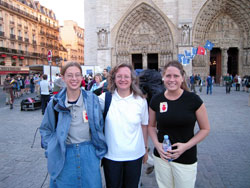Mother and daughter make pilgrimage on foot from Paris to Chartres

Theresa Latz, left, Jane Latz and Julie Brown pose on May 29, 2009, in front of the Cathedral of Notre Dame de Paris in Paris prior to the start of their three-day pilgrimage on foot to the Cathedral of Notre Dame de Chartres, 75 miles away, a famous medieval pilgrimage site. They are members of Our Lady of the Most Holy Rosary Parish in Indianapolis, and went on the pilgrimage together. (Submitted photo)
By Sean Gallagher
Seminarian Dustin Boehm ended his 10-week pilgrimage, made largely on foot, from southern France to Santiago de Compostela, Spain, on Pentecost Sunday—May 31, 2009.
On that same day, mother and daughter Jane and Theresa Latz completed a three-day, 75-mile pilgrimage on foot from the Cathedral of Notre Dame in Paris to the famous Gothic cathedral of the same name in Chartres, France.
But unlike Boehm, who often walked by himself in his journey of faith, the Latzes, members of Our Lady of the Most Holy Rosary Parish in Indianapolis, made their way to Chartres with approximately 10,000 other Catholics from several countries. (Related story: Finding Christ on 'The Way' - Seminarian grows in faith on centuries-old pilgrimage)
The pilgrimage, which has occurred annually for 27 years, is coordinated by the French organization Notre Dame de Chretiente, and is made mostly by Catholics attached to the traditional Latin Mass.
Both the pilgrimage to Santiago de Compostela and the one to Chartres are steeped in Church history. Pilgrims have walked along those paths for several centuries dating back to the Middle Ages. In fact, the way from Paris to Chartres was the first leg in one of the routes to Santiago de Compostela.
Theresa, a 17-year-old homeschooled high school senior, loves history—“ I’ll read history books practically all day long just like a book”—but the physical demands of the pilgrimage took over when she was actually on it.
“Once we actually got on [the pilgrimage], I focused more on the present,” she said. “You’ve got to go, and there are immediate needs.”
Some of those needs related to her mother, Jane, who had just recovered from a series of health problems.
Seeing how her daughter cared for her during their trek was a gift to Jane.
“We’d get to camp and she’d say, ‘Mom, just sit down and take your boots off. I’ll get everything set up [for the night]. I’ll go get you some soup and bread,’ ” Jane said. “It was truly charity and faith in action, both toward me, as her mother, and toward [other] people that were on the trip.”
Looking back on the pilgrimage, Jane said that it was “a walk of just absolute joyful thanksgiving for the incredible gifts that God gave me [in restoring my health].”
In worshipping on the pilgrimage with people from so many cultures who spoke so many languages, Theresa gained a new appreciation for the traditional Latin Mass.
“Overall, the greatest thing was probably [gaining] a greater appreciation for the [Church as the] mystical body [of Christ] as far as different countries and nationalities all being together,” Theresa said. “To know that we had French, German, American, English, Irish, Swiss, Spanish and most everything else you could name all going to one Mass was great.” †
